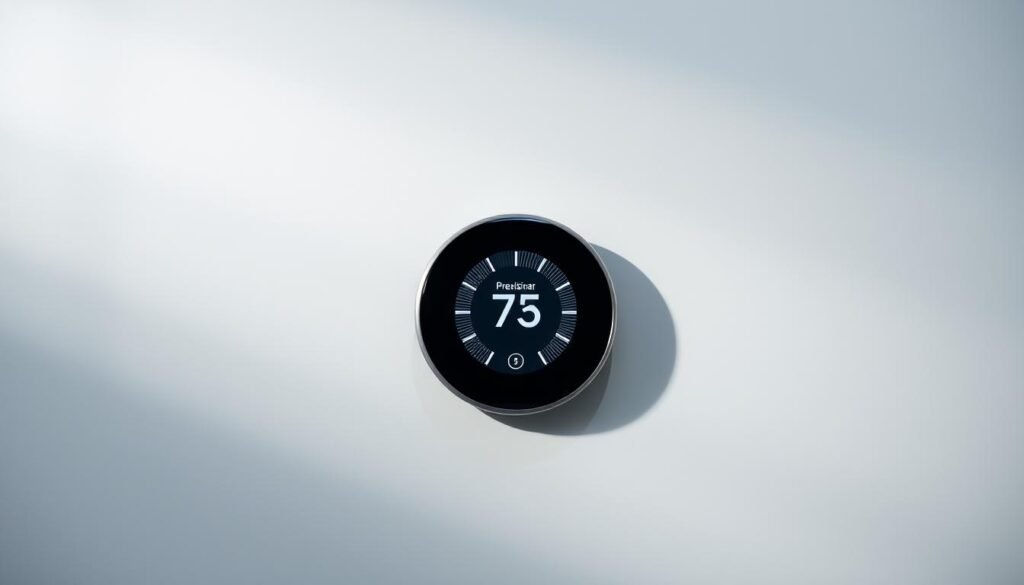Fact: Over 60% of U.S. households now rely on smart home tools that save time and cut costs, showing how innovation changes daily life fast.
Home goods that matter combine novelty with real usefulness. They solve both obvious and hidden pain points so they stick around, not fade as fads.
This list curates items shaping rooms across the house—audio hubs, streaming-focused living rooms, cleaning devices, climate control, kitchens, networking, security, and home communication.
We judge each pick by user value, updates, ecosystem fit, and market traction. That approach links bright ideas to everyday utility and long-term success.
Design thinking drives the picks: clarify, ideate, develop, implement. That process turns inventive ideas into easy-to-live-with solutions you can try today.
Key Takeaways
- True innovation pairs novelty with clear usefulness.
- Selections focus on comfort, convenience, control, and confidence.
- We evaluate real user value and measurable market traction.
- Design choices at component and experience levels matter most.
- Each entry highlights integrations, updates, and privacy controls.
- Look for ecosystem fit and ongoing improvement before adopting.
Why These Home Goods Are Truly Revolutionary, Not Just Trendy
The best household ideas are those that quietly remove friction from daily life. They solve what people can name and what they never thought to ask for. That mix of visible and hidden benefit defines true innovation.
New and useful means two things: the item fixes an obvious chore and it reduces unseen waste or risk. Early lighting and heating hazards are a clear example—modern solutions add schedules, sensors, and automation to lower those risks with little effort.
New and useful: solving explicit and latent pain points at home
Define “new and useful” as the core test. If a design only looks clever, it won’t last. If it simplifies setup and keeps delivering value, customers keep it in their routines.
Feasibility, desirability, viability: the innovation trifecta for products that last
- Feasibility: can engineers build it reliably?
- Desirability: do customers actually want it and use it?
- Viability: does the business model support updates and fair pricing?
Good design ties research, prototyping, and iteration to those three goals. Incremental changes often win when they target the real core job-to-be-done. Clear warranties, sensible pricing, and meaningful updates keep loyalty high and risk low.
Smart Audio Hubs: Amazon Echo and the Rise of Voice-First Homes
Smart speakers evolved from showpieces into everyday helpers you talk to naturally. Amazon Echo launched in 2014 with Alexa and shifted voice interaction into the home. David Limp framed the effort as customer-centered invention, focused on privacy and iterative updates.
From novelty to utility: AI assistants, privacy, and continuous updates
Everyday utility came from simple voice commands that handle music, timers, weather, and device control. That streamlined communication with services and made tasks hands-free across rooms.
Continuous updates improved recognition for accents and noisy spaces. Many features arrived via software so the product kept getting better without new hardware.
User experience meets platforms: services, skills, and third-party integrations
Echo’s rise hinged on wake-word accuracy, quick responses, and clear feedback. An expanding catalog of skills and third-party platforms turned a speaker into a home assistant gateway.
- Practical uses: kitchen timers, intercom calls, sleep routines, and smart lock control.
- Privacy tools: mic mute, status lights, and account-level controls for recordings.
- Buying checklist: supported services, platform compatibility, privacy needs, and device maturity.
| Feature | Why it matters | User action |
|---|---|---|
| Wake-word & response speed | Improves communication reliability | Test in your room before full setup |
| Privacy controls | Builds trust and data management | Review and set recording preferences |
| Third-party integrations | Expands use across lights, locks, and thermostats | Confirm platform compatibility |
Streaming at the Center of the Living Room
The move to internet delivery turned TV time into flexible, shared moments rather than fixed schedules.
From DVDs to Netflix: how streaming reshaped family entertainment and time
Netflix’s shift from DVD-by-mail to on-demand streaming created easy access and binge-watching habits. As of 2023 it reached 238.39 million subscribers, showing how one platform can change household behavior.
Smart TVs and interfaces: incremental innovations that changed the couch experience
Smart TV remotes and cleaner interfaces cut clicks and sped navigation. Faster app switching and clearer menus lowered friction and improved the overall user experience.
Personalized recommendations: the power of information and ideas in content discovery
Recommendation systems turn viewing signals into tailored suggestions. That algorithm-led guidance helps families choose quickly when options feel overwhelming.
- Platform features: profiles, parental controls, and watchlists keep shared discovery manageable.
- Industry advances: original content and adaptive streaming smooth playback across varied bandwidth.
- Choose by: app availability, interface responsiveness, search quality, and relevance of recommendations.
Note: Good streaming setups need solid bandwidth and home networking. That leads naturally into mesh Wi‑Fi and performance considerations next.
Cleaning Tech That Redefined the Chore: Bagless and Beyond
The best cleaning tools remove fuss, not just dust, by focusing on real user pains.
James Dyson’s bagless breakthrough came from a simple frustration: clogged bags that killed suction and made maintenance messy. He rethought airflow and separation, so the device kept its power without extra parts. That shift solved a clear problem and set a new bar in design and development.
Cordless sticks and quick cleanups
Cordless stick vacs vary by runtime, charge time, weight, and floor performance. Compare specs for your home: longer runtime matters in bigger spaces, while weight and maneuverability help daily pick-ups.
Robot essentials that actually help
Look for smart mapping, obstacle detection, no-go zones, and reliable docking. These features reduce babysitting and make cleaning schedules trustworthy.
- Hygiene-focused design: sealed systems and HEPA filtration cut allergens and simplify emptying.
- Performance features: auto-adjust suction, anti-tangle brushes, and floor-sensing tech improve results across carpets and hard floors.
- Development trade-offs: stronger motors can shorten battery life; denser filters may reduce airflow. Balance matters.
Choose by filtration level, runtime needs, and storage. Incremental innovation, when anchored in real pains, compounds into convenience that reshapes the cleaning industry.
“Good design solves the chore so you don’t think about it.”
Climate Control, Reimagined: Smart Thermostats and Energy Management
Smart climate systems use data and simple rules to keep rooms comfortable with less effort. They pair sensors, schedules, and learning to heat and cool only when and where it matters.

Design thinking for comfort: sensors, schedules, and savings
Sensors and schedules let a thermostat learn daily patterns and adjust automatically. Geofencing, occupancy detection, and local weather data refine routines so the system trims waste you would miss manually.
Setup and user experience matter: guided installation, HVAC compatibility checks, and clear app prompts make the initial steps simple. Intuitive apps translate data into actionable settings and readable energy reports.
- Energy reports & eco modes: show usage trends and small changes that drive real savings for customers.
- Integrations: voice control, smart blinds, and air quality sensors help the system coordinate across devices and services for better outcomes.
- Business value: rebates, extended warranties, and local support reduce ownership risk and lower payback time.
Evaluate algorithm transparency and control granularity so you can override or fine-tune behavior. Steady software innovation can add features over time, keeping a single product useful for years.
Kitchen Evolution: Smart Refrigerators as Information Hubs
Today’s refrigerators go beyond cooling; they gather and deliver useful household data. Smart models use the internet, internal cameras, and food tracking to show what’s expiring, suggest recipes, and flag items to restock. That shift turns a fridge into an everyday information center for the family.
From cooling to computing: inventory, cameras, and connected services
Internal cameras and barcode or manual entry let the fridge track inventory. Dashboards surface what to use first and offer recipe suggestions based on available ingredients.
Integrations with grocery platforms and voice assistants link lists and reminders to your usual shopping routines. Notifications reduce waste by turning data into practical prompts instead of cluttered alerts.
Sustainability and power management: energy efficiency as core innovation
Energy-efficient compressors, better insulation, and demand-response features cut power use and shift consumption away from peak periods.
Design decisions—door-in-door access, adjustable shelving, and clear interfaces—matter as much as apps. They keep everyday use simple and lower the friction that stops people from using smart features.
- Practical advice: check energy ratings and warranty terms on sealed systems before buying.
- Long-term value: prefer devices that add features via software updates so utility improves without new hardware.
- Core rule: the best innovative product still nails cooling performance, then layers in unobtrusive smarts.
Home Networking, Upgraded: Mesh Wi‑Fi for the Way We Work and Play Today
Mesh systems use multiple nodes to create one seamless network. This approach removes dead zones and keeps streaming and smart devices stable across the whole house.
Consistent throughput matters when families and remote teams stream video, join calls, and sync files at once. A steady link reduces lag, dropped calls, and stuttering media so communication stays clear.
Backhaul can be wired or wireless. Wired backhaul gives top performance. Wireless backhaul uses channel steering and band optimization to move devices to the best link automatically.
Simple app-based setup and automatic firmware updates are practical innovation. They keep security current and tune performance without manual work.
- Place nodes near open areas and stairwells; add one per 1,000–1,500 sq ft in dense homes.
- Check device capacity, Wi‑Fi generation support, and parental or guest network features.
- Match your ISP plan and modem to avoid paying for speeds you can’t use internally.
| Feature | Why it matters | Best choice |
|---|---|---|
| Backhaul | Maximizes throughput | Wired preferred; wireless acceptable |
| Device capacity | Prevents slowdowns under load | Choose higher-capacity units for many devices |
| App & updates | Keeps security and performance current | Easy app setup with auto updates |
Security and Peace of Mind: Video Doorbells and Connected Cameras
Security starts with timely signals and two-way audio that make checking the door effortless. Fast, reliable alerts and clear two-way communication decide whether a doorbell truly helps people at home.
Communication and alerts: what matters in user experience
Smart alerts should focus on relevance. Motion zones, package detection, and human recognition cut false alarms and surface the events a customer cares about most.
Two-way audio and quick video clips let you confirm deliveries or speak to visitors without opening the door. That direct communication reduces trips to the entryway and raises real convenience.
Storage, privacy, and device management
Compare storage choices: local storage keeps data on-site; cloud services add history, smarter detection, and easy sharing across platforms and households.
Privacy and data management matter. Look for encryption, strong account controls, and flexible retention settings so homeowners control who sees footage and for how long.
- Installation: battery vs. wired affects uptime and power management.
- Hardware: field of view and night vision should match your entryway layout and lighting.
- Scaling: device management must keep the app simple as coverage grows.
- Integration: link cameras to lights, locks, and alarms so alerts trigger helpful actions automatically.
| Feature | Why it matters | Practical tip |
|---|---|---|
| Local storage | No subscription fees; limited remote access | Prefer if privacy and offline access are priorities |
| Cloud storage | History, sharing, and advanced detection | Best when you want cross-device access and smart alerts |
| Hybrid | Combines redundancy and remote features | Choose for critical coverage and flexible management |
Finally, consider neighborhood context: network reliability, Wi‑Fi strength at the door, and local rules affect how well a system performs. Good device selection and modest planning deliver better security and less noise.
Communication at Home, Simplified: Large-Format Displays and Zoom-Ready Setups
Large screens and clear audio make remote conversations feel more like being in the same room. A modest setup change can cut fatigue and keep everyone focused during long calls.
Reliable video for teams and people: learning, work, and family connection
Pair a large-format display with a quality webcam and a directional mic to create a natural sightline and fuller sound. That combo helps teams and families read faces and tone without leaning forward.
App-level innovation—noise suppression, clear screen sharing, and breakout spaces—supports varied collaboration modes. These software tools improve the user experience more than chasing tiny resolution gains.
Privacy and security iterations: waiting rooms, encryption, and controls
After early concerns, major platforms added waiting rooms, meeting locks, passcodes, and end-to-end encryption to restore trust. Zoom’s rapid security updates show how simple defaults and better controls drive success today.
“Simplicity and strong defaults rebuild trust while keeping meetings easy to run.”
- Setup tips: camera at eye level, soft frontal lighting, and basic audio treatment for clearer sound.
- Household uses: schoolwork, telemedicine, remote work, and family gatherings benefit from simple controls.
- Management: keep firmware and apps current, check bandwidth, and avoid heavy downloads during calls.
Choose a balanced stack that “just works”: reliable devices, sensible software, and a mesh network check will deliver steady communication and low friction for daily life.
How to Choose Revolutionary Products for Your Home
Picking the right home tech means matching real needs to reliable delivery over time. Start with the problem you want solved and then check how a new product will fit into daily life. That mindset keeps hype from driving costly mistakes.
Revolutionary products checklist: pain points, UX, and long-term updates
- Define the core pain point: write one sentence that explains the chore or risk you want fixed.
- Test the UX: try features in real tasks through demos, return windows, or starter bundles.
- Confirm compatibility: ensure the item integrates with your hub, voice assistant, and daily routines.
- Track updates: look for a clear update history and transparent development roadmap from the company.
Innovation types in plain terms
Think of innovation in three simple buckets.
- Incremental: small wins like better filters or longer runtime that improve a device over time (example: Dyson’s vacuum refinements).
- Sustaining: steady UX and feature lifts, such as cleaner TV interfaces that help current users.
- Disruptive: big shifts that change behavior—Netflix’s move to streaming is a classic example innovative products buyers should study.
Business model matters: subscriptions, platforms, and customer support
Compare long-term costs: subscription fees for cloud history or premium features add to total cost of ownership.
Check for platform lock-in risks and how companies communicate warranties, support, and roadmap details. A solid business model shows how a new product will be supported, updated, and managed over years.
“A clear rubric beats impulse buys: score pain-point coverage, UX clarity, ecosystem fit, and evidence of ongoing innovation.”
Conclusion
A smart home idea succeeds when it saves time and fits into daily routines. The recent evolution of phones, streaming, cleaning, and voice hubs shows that steady improvements matter more than one big breakthrough.
Across the world, electric vehicles and efficient appliances share lesson: better power use, clearer defaults, and honest controls turn clever tech into everyday value. Look for companies that push updates, protect privacy, and link services so information flows where it helps.
Start small: pick one product that meets a real need, let teams and family adapt, then expand. Use the checklist from this guide to judge fit and long-term success — making adoption part of smarter living, not a sprint.
FAQ
What makes a home good truly innovative rather than just trendy?
An innovative home item solves explicit or hidden pain points, is desirable to users, and is financially viable for makers. It combines smart design, reliable technology, and clear value—like saving time, improving comfort, or reducing energy use—so it stays useful beyond a short fad.
How do voice-first hubs such as Amazon Echo change daily routines?
Voice hubs let people control lighting, play music, manage calendars, and access services hands-free. Continuous firmware updates, expanding third-party skills, and integration with smart home devices turn novelty into practical utility, while privacy settings and local processing address security concerns.
Why did streaming reshape family entertainment so thoroughly?
Streaming replaced physical media by offering instant access, personalized recommendations, and on-demand viewing across devices. That changed how families schedule time, discover content, and share viewing, while platform algorithms and user data improved relevance and retention.
What user-experience improvements make smart TVs and streaming interfaces better?
Clear navigation, fast search, cross-platform profiles, voice control, and seamless app switching all reduce friction. Incremental design changes—better remotes, reduced latency, and smarter content curation—improve the couch experience without forcing users to relearn basics.
How did Dyson’s bagless design change vacuum cleaners?
Dyson applied cyclonic separation and industrial design to fix clogging and loss of suction common in bagged vacuums. The result was easier maintenance, consistent performance, and a new expectation for durability and engineering in home cleaning tools.
What should I look for when comparing cordless stick vacuums and robot cleaners?
Check runtime, suction power, filtration (HEPA if you need allergen control), and smart features like mapping and scheduling. Consider maintenance costs, weight, and how each fits your living space—robots handle routine floors, while sticks tackle stairs and quick spot cleanups.
How do smart thermostats deliver energy savings?
Smart thermostats use sensors, learning algorithms, and schedules to cut wasted heating and cooling. They adapt to occupancy, offer remote control via apps, and integrate with home energy systems to reduce bills while improving comfort through precise climate control.
In what ways are modern refrigerators becoming information hubs?
Smart refrigerators add cameras, inventory tracking, touch displays, and app connectivity. They help manage groceries, suggest recipes, and connect to delivery or shopping services, shifting from passive appliances to active parts of a connected kitchen.
Can smart kitchen tech actually improve sustainability?
Yes. Energy-efficient compressors, better insulation, and intelligent power management reduce consumption. Inventory features and expiration alerts also help cut food waste, while firmware updates can optimize performance over time.
Why is mesh Wi‑Fi better for today’s homes than a single router?
Mesh systems use multiple nodes to provide consistent coverage across larger or multi-story homes. They reduce dead zones, support many simultaneous devices, and adapt routes dynamically, making them ideal for remote work, streaming, and smart devices.
What matters most in home security cameras and video doorbells?
Image quality, reliable motion detection, low-light performance, fast notifications, and clear two-way audio are key. Secure cloud storage, local backup options, and strong encryption help protect privacy while giving useful alerts and footage access.
How do large-format displays and Zoom-ready setups improve home communication?
Bigger screens with good cameras and microphones make remote meetings and family calls feel more natural. Hardware that supports stable video, noise reduction, and easy screen sharing helps teams and households collaborate with fewer interruptions.
What privacy and security features should I expect from video conferencing at home?
Look for encrypted connections, meeting passcodes, virtual waiting rooms, and user controls for camera/microphone access. Hardware vendors often add firmware updates and enterprise-grade security options for sensitive work or education use.
How do I evaluate whether a home innovation will still be useful in five years?
Assess the product’s update policy, developer ecosystem, and compatibility with open standards. Consider the track record of the brand, availability of parts and support, and whether the core function addresses a lasting need rather than a fleeting trend.
What role do business models play in choosing connected home devices?
Business models affect long-term value. Subscription services, cloud dependencies, and platform lock-in can add recurring costs or risks. Prefer products with clear upgrade paths, transparent fees, and strong customer support to avoid surprises down the line.
How can I balance innovation with ease of use when buying smart home gear?
Prioritize intuitive setup, reliable integrations with platforms you already use, and devices that solve a specific problem. Read reviews focused on real-world UX, check compatibility, and start with a small deployment before committing to a full-system purchase.
Are there affordable ways to adopt advanced home tech without overspending?
Yes. Look for modular systems, entry-level models from reputable brands, and seasonal sales. Focus on high-impact upgrades—mesh Wi‑Fi, a smart thermostat, or a quality doorbell camera—rather than buying many niche gadgets at once.



